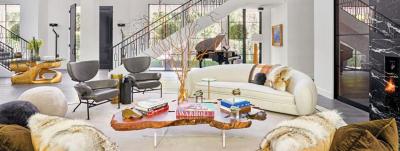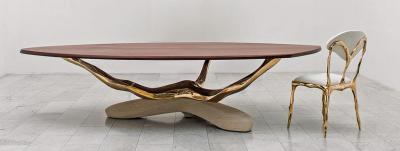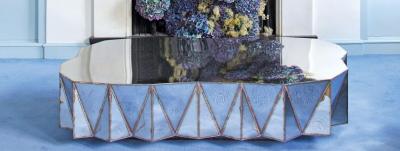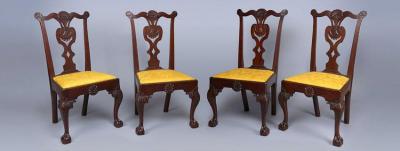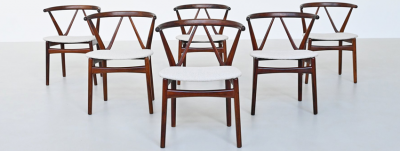The Timeless Elegance of Barovier & Toso Decorative Glass and Lighting
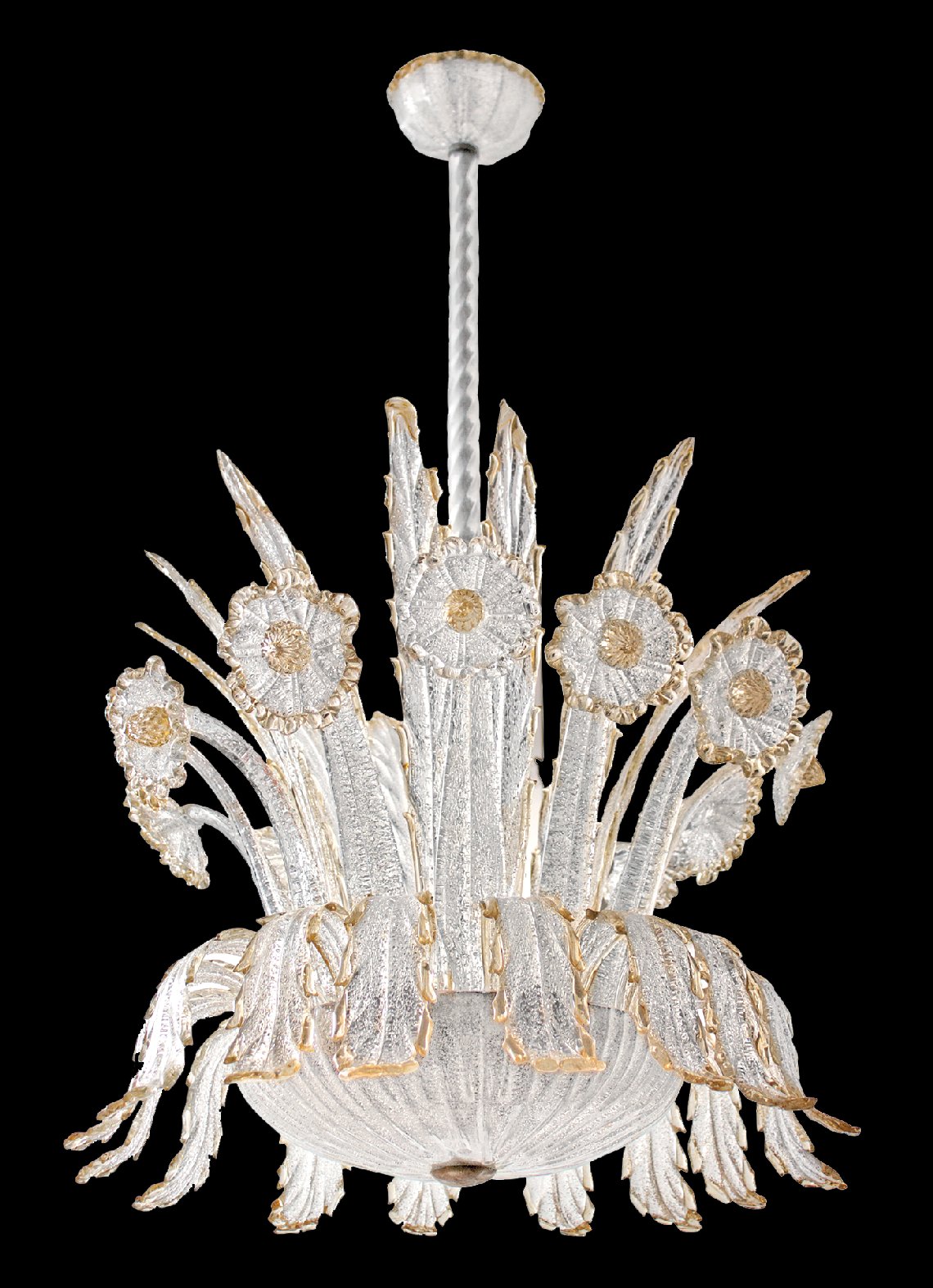 | ||
| Left: An elegant Art Deco Murano glass chandelier by Ercole Barovier, circa 1930. This rare model was selected by architect/designer Melchiorre Bega to decorate the Palazzino Majani in Bologna. Pulegoso bubbles create a frosted effect on the canopy and the tiered shades, enclosed in a cage of gracefully arching crystal fronds. From Veneziani Arte on Incollect. Right: A lustrous and shimmering chandelier in a fountain-like form, with gold-trimmed leaves spilling from a ribbed bowl holding a ring of stemmed flowers and upright leaves, circa 1940. From Thomas L. Stewart Antiques on Incollect. | ||
 |
Craftsmanship is the word that comes to mind when thinking of Barovier & Toso, a legendary Venetian glassmaker founded in the late 13th century by Jacobello Barovier, owned and operated by his descendants until 2022. Elegance and refinement are other terms that come to mind, for Barovier & Toso has built up a reputation as the supplier of artisanal quality chandeliers, mirrors, and expensive decorative objects to the world’s very rich, royal, and famous.
Barovier & Toso is three brands rolled in one, following a marriage between members of two prominent Murano artisanal glassmaking families, Ferro and Toso, leading to the formation of a company called Ferro Toso in 1901 and a subsequent merger in 1936 with the then 650-year-old Barovier family glass business, Vetreria Artistica Barovier & Co. The merger modernized the two businesses and led to a period of unprecedented creativity under the direction of Ercole Barovier, a descendant of Jacobello Barovier and master glass designer.
 |
Tangerine Dream: Classic form catapulted into contemporary style via bold, vivacious color. A contemporary Barovier & Toso piece from Casanova Venetian Glass & Art on Incollect. |
Ercole Barovier is a pivotal figure in the long history of Barovier & Toso and one of the most famous and accomplished glass art designers of all time. “Ercole Barovier changed the Murano glass world with his innovative and daring spirit but always with an irremovable conviction that Murano glass art embodies grace, energy, and respect,” says Fabienne Cosulich from Cosulich Interiors and Antiques in New York, one of the primary dealers in the material across the United States.
Despite his formidable place in the firm’s history, Ercole Barovier did not intend to spend his life in service to the family glass business. He originally studied to become a doctor, but following the First World War returned to Murano and joined the family glassmaking business. He was appointed creative director in 1926 and the chief designer in 1927, a post he held until his retirement in 1972, leaving behind a catalog of over 25,000 designs for everything from vases and lamps to tables, chairs and chandeliers.
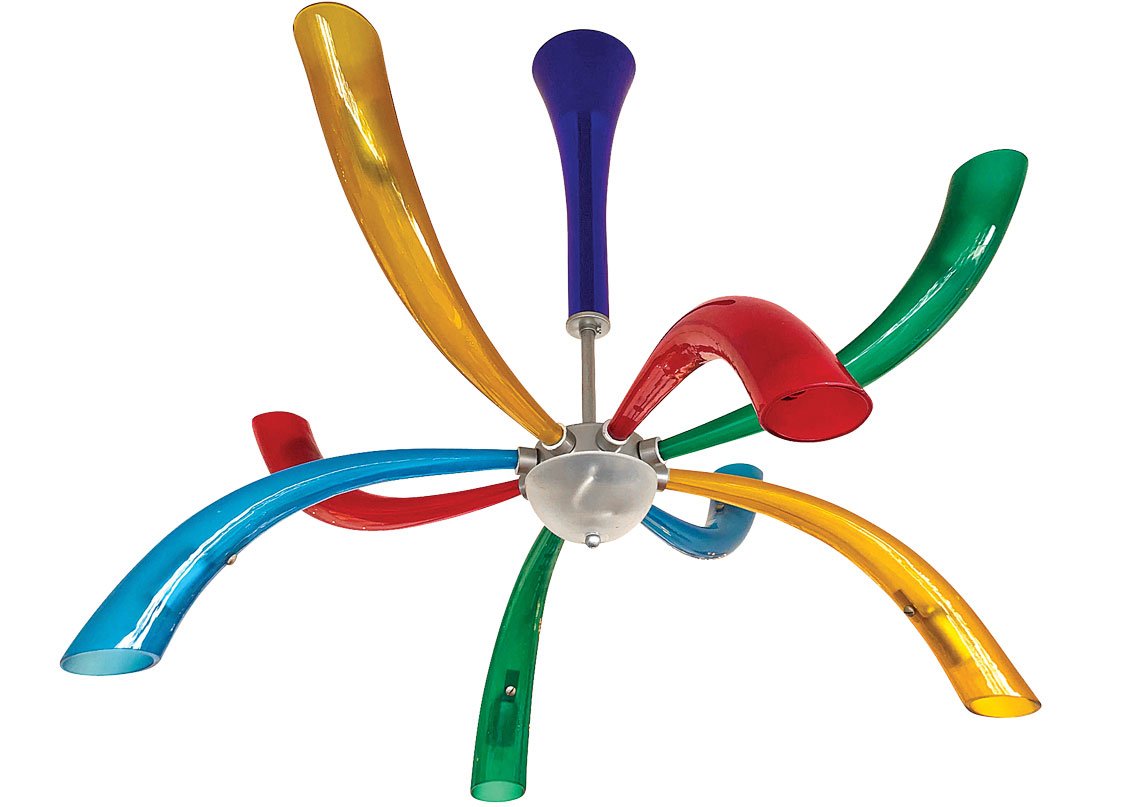 |
Barovier & Toso “Fireworks” chandelier circa 1990s, with adjustable arms that can be positioned up or down. From Stanislas Reboul on Incollect. |
Prior to the mid-20th century and the innovations of Ercole Barovier, Barovier & Toso was famous for formal chandeliers made for mansions and royal houses. It was Angelo Barovier, by several accounts, who in 15th-century Venice invented the first completely transparent, brilliant crystal-like glass by bleaching the molten glass through the use of manganese and other metallic agents. Known as cristallo in Italian, this simple if revolutionary innovation led to the creation of the glittering clear crystal chandeliers that became symbols of taste and elegance among nobility during the Renaissance.
Subsequent centuries saw designs for chandeliers and glass objects at Barovier & Toso taking inspiration from decorative Baroque and Rococo styles of the 17th and 18th centuries which, in turn, drew upon neoclassical Renaissance models. Two World Wars, modernism, the widespread availability of electricity in homes, and the decline of the noble houses which once were Barovier’s chief patrons changed all that and the company struggled to adapt.
Cristallo continued to be used in the production of glass items through subsequent centuries and today is still used in the production of magnificent chandeliers for royals, designers, and luxury brand clients including Louis Vuitton and Bulgari. In 1980, they created the modern ‘Taif’ chandelier for Saudi King Khalid which involved more than 2,000 pieces of glass. The design caught the attention of luxury brand Dolce and Gabbana, who commissioned a scaled-down version for their boutiques. The firm made fifty 32-foot-long chandeliers for the Hassan II Mosque in Casablanca.
“The Barovier & Toso name has been the hallmark of Venetian lighting for centuries,” says Keith Davison from Casanova Venetian Glass and Art in Naples, Florida. “Their chandeliers are found in top hotel lobbies, restaurants and private estates throughout the world,” Davison says. His showroom offers lighting from Barovier & Toso as well as creations from over 65 other glass masters and firms from the Island of Murano. He is a fan of Murano art glass, but Barovier & Toso is a particular passion.
 | |
“Glassa” wall sconce in salmon blown glass and charcoal enameled metal by the late, much-lauded Italian architect and designer Rodolfo Dordoni for Barovier & Toso, 1988. From Munich Modern on Incollect. |
The gallery Veneziani Arte in Rome has an astounding collection of Barovier & Toso glass with an emphasis on historical chandeliers, and today has one of the best shopping selections in the world for anyone in the market for a major piece of vintage glass art. Among the chandeliers they have is an iconic 1930s–1940s Art Deco chandelier with jagged cristallo glass leaves or lighting bolts encasing tiers of milky white bowls. This was a model for a chandelier used by architect Melchiorre Bega for the historic Cafe Majani of Bologna, Italy. A similar model was installed in the historic Gambrinus Cafe in Naples, a gathering place for artists and intellectuals in this southern Italian city since 1860.
Ercole Barovier was an artist of his time and introduced a modern sensibility that completely reinvigorated and reinvented the amalgamated brands of Ferro Toso and Barovier. The range of offerings and price points was broadened to include a spectrum of functional glass objects in a variety of designs that were amenable to 20th-century homes. It was a question as much of survival as taste, but to his credit, Ercole Barovier found ways to innovate and evolve the brand while remaining true to its classical design roots as well as the traditional handmade arts of Murano glass.
His creative melding of the old and the new to meet changing times can be seen in the Medusa electric torchiere table lamp by Ercole Barovier, for Barovier & Toso circa 1935, offered by The Moderns in London. Not only is this a functional electrical lamp, but it is beautifully made of Venetian crystal blown glass with an iridescent surface designed like a flame made of points of glass pulled from a hot vessel with pliers. “It is like a torch of fire, in Venetian blown glass crystal with iridescent surface effects,” says Jozefien Gronheld at the gallery.
Even today the brand continues to evolve and innovate — take for example the flush mount sconce or wall lamp, “Glassa,” by Rodolfo Dordoni from 1988 for Barovier & Toso and offered by Incollect dealer Munich Modern. Executed in salmon-colored thick glass and enameled metal, this design looks like a butterfly fluttering through the air. Vintage lighting dealer Stanislas Reboul has a marvelous contemporary Fireworks chandelier by Barovier & Toso, from the 1990s, in which the arms can adjust up or down.
Casanova Venetian Glass & Art shows numerous contemporary glass designers working with Barovier & Toso. Casanova was founded 18 years ago by Keith Davison & Marina Montmorency in Naples, Florida, and they recently opened a second gallery there. Their two showrooms feature one of the largest selections of Murano glass in the United States, including a variety of contemporary creations from Barovier & Toso, such as a pair of ultra-modern looking table lamps in deep red and blue glass as well as a playful bright orange 8-arm glass chandelier.
Barovier & Toso is still located in Murano and everything continues to be made with Murano-blown glass, known as Venetian crystal, a material that is produced in small batches from a mix of local silica sand, ash, and other materials including limestone and coloring additives. Each glass batch is melted in a furnace at temperatures of over 1,400 degrees Celsius, removed from the furnace, and then blown, molded, etched, or sculpted into the desired shape or design.
Barovier & Toso glass has always been handcrafted using these traditional techniques, most of which are little known or understood outside the glassmaking community. Here we profile some of the objects they have made as well as the designers who have worked with the brand along with some processes and techniques they have invented or employed to manufacture glass items.
 |  | |
| Left: Designed by Ercole Barovier as part of his 1940s “Lenti” series, a cylindrical blown glass vase of clear and verdigris-colored glass with applied hemisphere-shaped “lenti” (lenses) infused with flakes of gold leaf. From Società Antiquaria on Incollect. Right: A marvelous example of the Lenti technique, also from the 1940 Lenti series, this sparkling pendant light has a deep bowl decorated in cascading bands of lenti, with a decorated stem and canopy that mirrors the bowl shape. From soyun k. at The Gallery at 200 Lex Powered by Incollect. | ||
Lenti
Ercole Barovier invented numerous new techniques for making and decorating glass. Among his most inventive and original designs are his Lenti series of vases, bowls, and lamps, beginning in the early 1940s, for which he reinterpreted the ancient technique of making cased or dual-layer glass — here layers of glass in contrasting colors are combined. For his Lenti series, Ercole Barovier began with a thin layer of inner glass in colors onto which he attached thick, convex, lens-like semi-circular bubbles or glass (lenti in Italian means lenses) in which exploded gold leaf or gold flakes are suspended. The casing creates magnificent and varying optical effects.
The Lenti series was technically complex to make with no two pieces entirely the same and for that reason, they remain among Ercole Barovier’s most prized and sought-after designs. A cylindrical glass vase from the Lenti series from the 1940s being offered by Società Antiquaria is an example of his creative use of metals and oxides in the Lenti pieces: a layer of glass colored with copper to give a green color is cased in large appliqué molded round lens shape bubbles filled with burst gold leaf to form a multilayered and textured design that is immediately striking. “This is a very rare cylindrical blown glass vase from the Lenti series — designed by Ercole himself — formed by layers of glass colored with gold leaf and decorated with large molded hemispheres,” says Cecilia Paccagnella from Società Antiquaria in Turin.
soyun k. has a beautiful colorless crystal glass chandelier from the Lenti series with, as the gallery explains, “semi-spherical applications and fused lenti shade, stem, and canopy.” Here the emphasis is on the glass-blowing method which incorporates many dozens of small glass spheres or balls covering the item. “The Lenti series in the 1940s is a fine example of Ercole Barovier’s cutting edge production in which several thick layers of blown and molded glass or “cased” glass are applied in hemispherical form,” says Margaret Kim from soyun k.
 |
Among the most interesting techniques developed by Ercole Barovier in the 1930s is crepuscolo, (twilight) in which steel wool is inserted between layers of molten glass before blowing into its final form. Smokey threads rise and swirl throughout, giving a mysterious effect; this design is further embellished with applied medallions of clear glass. From Pavilion Antiques and 20thc on Incollect. |
 | |
A “vide poche” (empty pocket) or small trinket dish named as such for its original purpose, which was to hold keys and pocket change, by Ercole Barovier. It is a fine example of the glassblower’s art, combining randomly dispersed pulegoso bubbles with gold leaf avventurina inclusions. From Atomic Antiques at The Gallery at 200 Lex Powered by Incollect. |
Avventurina
Avventurina is an interesting type of glassmaking invented in Murano around 1620 by accident, or so the story goes. Legend has it a 17th-century artisan dropped some metal shavings into a glass mixture leading to some accidental if attractive and shimmering translucent visual effects — hence the name, derived from the Italian expression ‘all avventura’ which in English means ‘by chance.’ Today the technique refers loosely to a variety of translucent glass with sparkling inclusions of gold, copper, metal, or oxides used to create designs and color within glass.
Offered by Atomic Antiques, a very nice, small glass “vide poche” signed by Ercole Barovier is a good example of how the artist often combined several glassmaking techniques in a single object. In this piece, we see gold leaf avventurina-style inclusions combined with random bubbles, made using a technique known as pulegoso. A striking crepuscolo table lamp at Pavilion Antiques, circa 1930–1935, also designed by Ercole Barovier, is designed using glass decorated internally using slivers of burned wire wool or steel wool, creating mysterious whimsical patterns in brown to black. Clear glass medallions applied to the outside of the lamp base provide added interest.
 |
Left: Ribbed baluster form table lamp in an unusual rich teal color with streams of bullicante technique controlled bubbles and silver avventurina inclusions, by Barovier & Toso, circa 1950s. From Epoca on Incollect. Right: Barovier & Toso table lamp in gradient aquamarine with 24-kt gold dust avventurina. Three freeform clear glass shapes with large bullicante bubbles swirl around the vase-shaped body, which rests on a conical base. Circa 1960s. From Cosulich Interiors & Antiques on Incollect. |
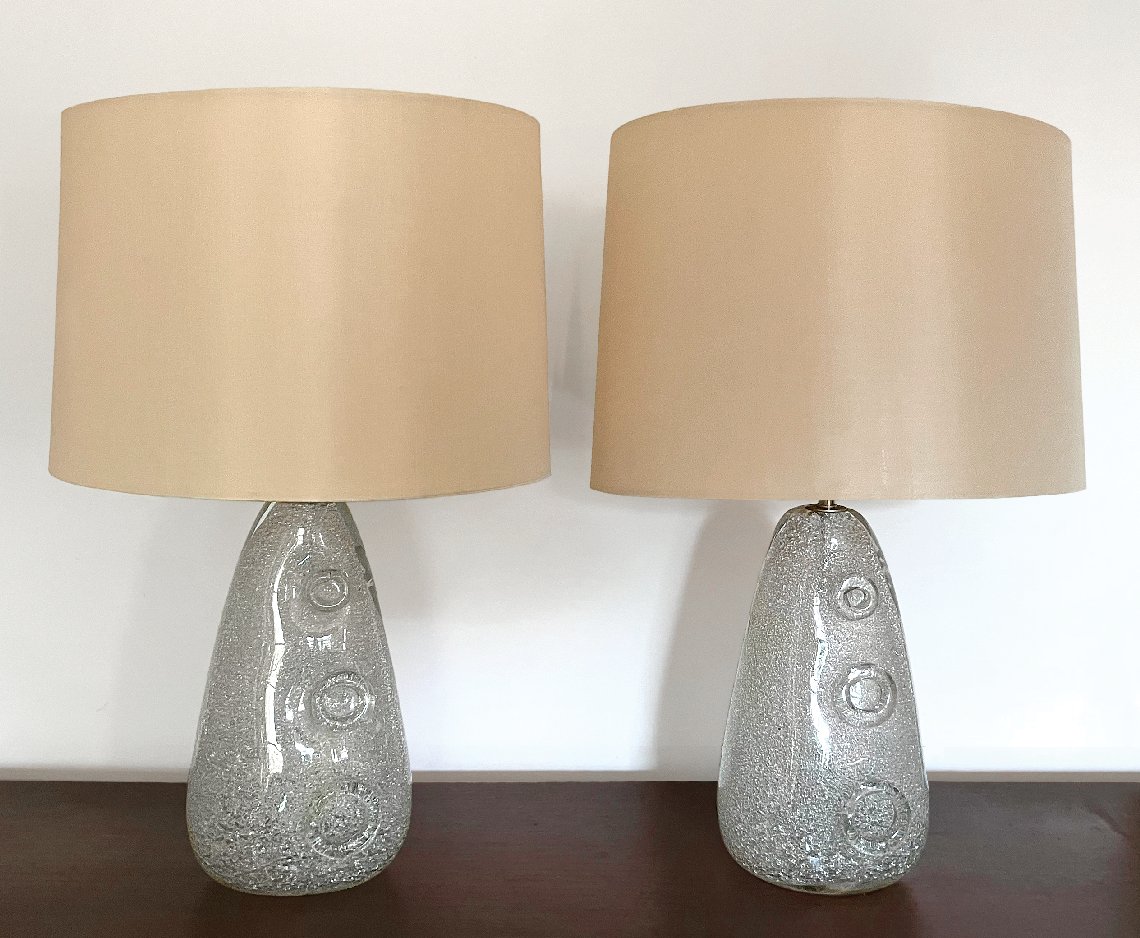 |
Ercole Barovier’s 1938 patented technique “Rugiada” (dew) created the fizzy crackled effect in this pair of Dewdrop table lamps. Tiny particles of clear glass are cast onto the surface of the glass sheets, which then become partially melted, resulting in an uneven interior texture that creates a varied and fascinating diffraction of light. From Modest Designs at The Gallery at 200 Lex Powered by Incollect. |
Rugiada
“Ercole Barovier invented the Rugiada technique in 1938, and the process was then patented and was exclusive to the company,” explains Modest Designs, which is offering a rare, unusual example of this technique in which fragments attached to the glass give it the look of dew drops. The item is a pair of “dew drop” glass table lamps, produced by Barovier & Toso, in which colorless glass grit and shards were applied onto the surface of clear glass during production leading to a stunning and distinctive surface patina. “When the object is heated, the particles are partially melted and fuse to the solid surface, creating an internal crackled design,” the gallery says and explains: “The technique was often used to make shades, where the texture produces marvelous lighting effects. In these examples, the technique marries to the pyramidal form to evoke both the ancient and modern qualities of the glass.”
 |
An exuberant 1970s Barovier & Toso “Sputnik” chandelier in glittered green hand-blown Murano glass with ribbed orbs in three graduated sizes and ribbed palmette leaves on brass stems. From Domus Aurea on Incollect. |
Murrine
Today, murrine is a popular decorative technique used in glassmaking. It involves creating colorful mosaic-like designs by layering and then fusing small pieces of colored glass sliced from glass rods also containing patterns. A central glass rod is dipped in colored melted glass to build up layers and patterns. The technique was brought to Italy millennia ago from Egypt at around 60 BC but is thought to have originated with the Phoenicians, who used it to make beads. In the late 19th century glassmakers on Murano revised the technique, including the two brothers Benvenuto and Giuseppe Barovier, who introduced the fabrication of what they termed “murrini fusi” glass.
Murrine glass ranges from the familiar intricate millefiore paperweights to modern ‘tessere’ designs such as a 1960s Barovier & Toso designed in caramel and black glass pendant light offered by Illustris. The blown crystal clear glass shade is worked ‘a tessere’, in a geometrical design of murrine in caramel rectangles outlined with black.”
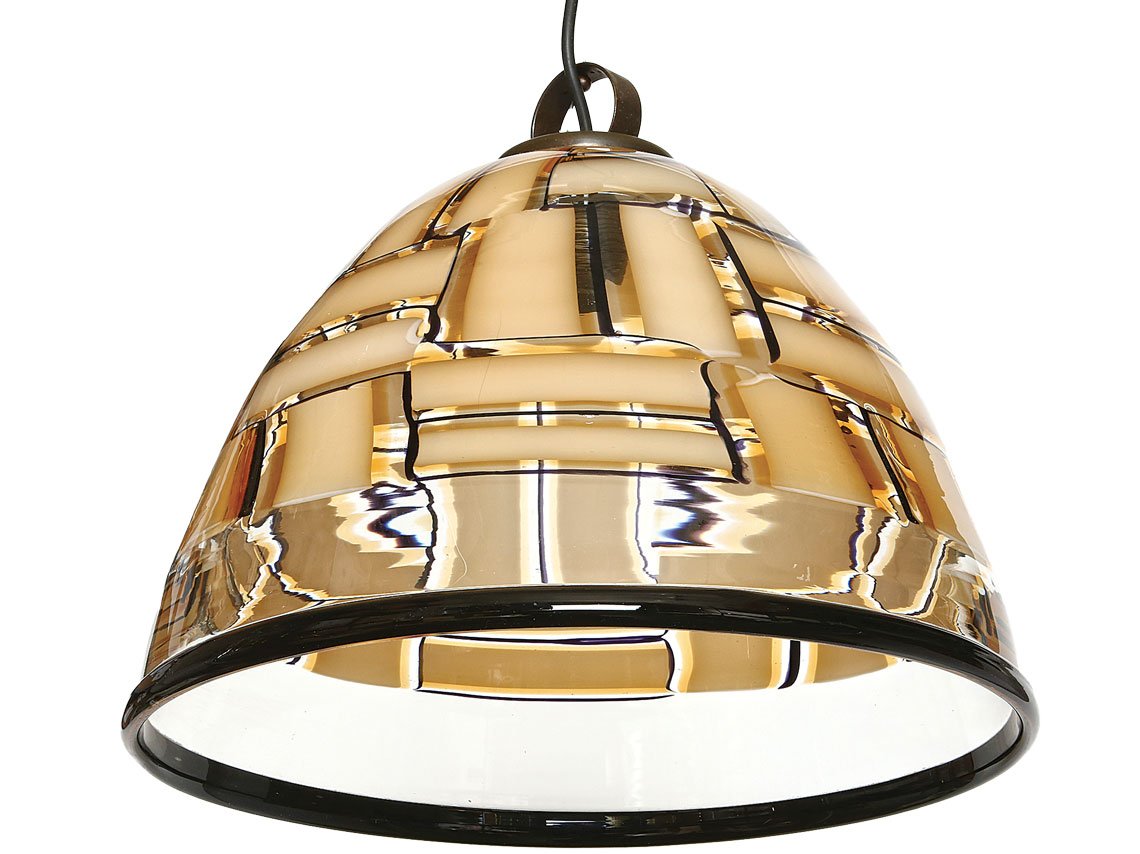 |
A 1960s Barovier & Toso “Tessere” pendant light in a patchwork design of light and dark amber glass tessere (tiles) edged in black. From Illustris on Incollect. |
Pezzato/Tessere
Pezzato is a version of the murrine style and is made by arranging a patchwork of rectangles in different colored pieces of glass that are then heated until they melt to create a linked design. Then another, usually pre-prepared blown form, made of colorless glass, is rolled over it, transferring the pattern to the glass form. This technique was used for centuries before the invention of the glass blowing pipe (around the 1st century BC by Syrian glass craftsmen and quickly adopted by the Romans) but was revived and refined in the modern era by Murano designers. “Pezzato” vases are among the most desirable items designed by the legendary Italian designer Fulvio Bianconi for the company Venini & Co, another of the most famous and important Venetian glass makers.
 |
A magnificent “Pezzato” (dappled) table lamp in a checkerboard pattern of pink and white lattimo (milk glass) by Ercole Barovier, circa 1950s. From Lobel Modern on Incollect. |
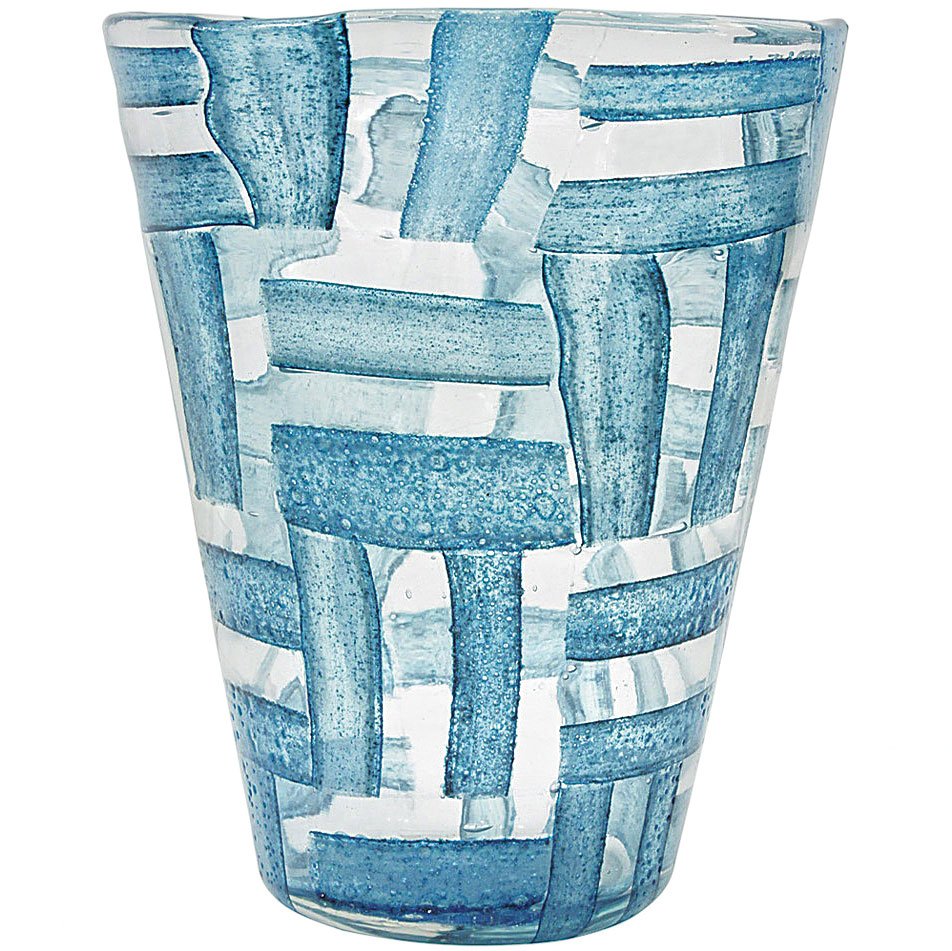 | |
“Alterni” vase in clear and light blue tessere edged in darker blue. Alterni pieces are very rare. By Ercole Barovier, 1958. From Lobel Modern on Incollect. |
Tessere means ‘tiles’ in Italian and this technique was widely utilized by designers at Barovier & Toso to create some strikingly contemporary pieces of glass design, such as an exquisite Tessere Ambra vase for Barovier & Toso, created circa 1974 by an unidentified designer, offered by Donzella. This is an immensely beautiful hand-blown vase with, as Paul Donzella explains, “very deep amethyst and amber colors formed to resemble woven material.” It is signed on the underside “Barovier & Toso Murano” as a guarantee of the maker and authenticity.
Evan Lobel, the owner of Lobel Modern, has a pair of extraordinary items designed by Ercole Barovier for Barovier & Toso, both using the tessere method. His rare and important hand-blown glass “pezzato” table lamp with pink and white lattimo tessere from the 1950s is a signature example of hand craftsmanship using this technique, “It’s an exquisite table lamp,” he says, “just stunning.” Lobel says. He is right, for the craftsmanship is matched by the beauty of the design. The other piece he is offering is an Alterni vase in which alternating blocks of glass are randomly or loosely blown together. “The blue in the glass is sublime with a subtle texture,” Lobel says about the vase, which combines clear and light blue glass tessere, edged in darker blue, making it seem as if the blue pieces are floating freely in space.
 |  | |
Left: “Medusa” table lamp by Ercole Barovier for Barovier and Toso, circa 1935. Venetian crystal with iridescent surface. From The Moderns on Incollect. Right: “Grosse Costolature” vase in heavy iridescent Murano glass with incised decorations. Designed by Ercole Barovier and manufactured by Barovier & Toso, circa 1943. From Donzella on Incollect. | ||
Iridescence
The Toso family was renowned for their use of iridescent glass, a centuries-old technique the Toso designers incorporated to achieve an especially luminous effect. Iridescent glass reflects various colors, obtained by a special process in which, as dealer Paul Donzella explains, “While he is shaping it, the artist holds the article over the vapors of melted salts of metals like tin and titanium. The vapor makes the white glass exhibit the component colors of the rainbow.” Donzella is offering one of the most popular designs by Ercole Barovier, a large and expressive Grosse Costolature vase in heavy iridescent Murano glass with incised decoration. Colors vary on these pieces as they were often designed to mimic the look and feel of marine life.
 |
1960s Barovier & Toso Murano glass table lamp with sommerso, bullicante, and avventurina decorative techniques, carved and gilded wood base. From Venfield on Incollect. |
 | |
Barovier & Toso “Zebrato” sommerso pattern Murano scalloped rim glass bowl with clear glass alternating with brown in the sommerso technique, enhanced with gold leaf inclusions in the protruding ribs. Circa 1980s. From Casanova Venetain Glass & Art on Incollect. |
Sommerso
Sommerso, the Italian word for “submerged,” is the Murano glassmaking technique of creating multiple layers of contrasting colored glass without mixing together the colors. Master glassmakers create the effect by dipping colored glass into molten glass of a different color, any number of times, then blowing the glass into a form, widely used for creating bottles, vases, and sculptures. Venfield is offering a Barovier & Toso sommerso table lamp from the 1960s. This technically complicated and beautiful object employs several glassmaking techniques, sommerso as well as bullicante in which air bubbles are blown or injected into the glass to form controlled patterns. There are also avventurina throughout. Casanova has a Barovier & Toso glass bowl in the Zebrato Sommerso pattern, with many layers of zebra-like stripes in dark brown alternating with clear glass infused with extensive gold leaf.
 |
Barovier & Toso leaf-form wall sconces circa 1950s. Pulegoso bubbles and gold leaf inclusions give an overall “frosted” effect, creating soft ambient lighting. From Venfield on Incollect. |
 | |
Hand-blown pulegoso vase by Ercole Barovier. The simplicity of form and pale aqua color accentuate the ethereal beauty of the pulegoso technique in this exceptional piece. With applied foot and a column of three clear glass buttons on either side, circa 1942. From Donzella on Incollect. |
Pulegoso and Bullicante
Pulegoso is related to bullicante as a glass-making technique but distinguished by intention: with bullicante, the bubbles are controlled and regular, but in the pulegoso technique the bubbles form randomly throughout the molten glass, as seen in a cordonato d’oro vase created by Ercole Barovier in the 1950s for Barovier & Toso, offered by NYC Modern. Donzella has a circa 1942 hand-blown pulegoso vase with applied foot and circular buttons designed by Ercole Barovier.
Pulegoso is made by adding substances such as gasoline to molten glass, causing it to boil and fuse irregular air bubbles to create dynamism and a sense of movement. Venfield has a pair of neoclassical-style pulegoso leaf sconces from the 1950s with gold incrustations that are timeless in their appeal. San Francisco decorative arts gallery Epoca is offering a mid-century bullicante art glass lamp by Barovier & Toso, in teal with silver inclusions, that the gallery describes as a “ribbed baluster form with a splayed scalloped foot resting on a giltwood base.” “I love this particular lamp, not only for the beautiful, deep blue-green but the masterful creativity behind its creation with its controlled bubbles and silver aventurine, or metal flecks,” says Eric Petsinger at the gallery.
 |
A bold eight-arm Barovier & Toso chandelier in the rostrato technique, developed by Ercole Barovier in 1938. Peaks are hand-pulled from the hot glass with pliers, creating a profusion of sparkling reflective surfaces. Rope twist surfaces on the stem and arms create another texture and more reflective surfaces. Circa 1940s. From The FM Gallery on Incollect. |
Rostrato
The Rostrato technique was developed by Ercole Barovier in 1938 and involves the glass maker pulling out a series of peaks from the glass with flat pliers while it is still hot. The resulting beak-like protrusions give the object texture and form, creating depth as well as surface distortions and a sculptural quality. Rostrato objects are among Ercole Barvoier’s most famous, desired works of art. Veneziani Arte has terrific glass chandeliers from Barovier & Toso using the rostrato technique, including an effusive five-shade Art Deco chandelier by Ercole Barovier from 1940.
An 8-arm glass rostrato chandelier by Barovier & Toso, offered by The FM Gallery is another fine example of glassmaking, also using the Rostrato technique. “This is a splendid and rare chandelier from the 1940s,” says Michael Ahose from the gallery in London. “This chandelier was executed with the typical ‘Rostrato’ technique in thick and transparent glass mounted on a thick metal structure with brass coverings as details. Here we have an iconic example of the prestigious art of Murano’s glass interpreted with a new dynamic uplifted vision that expresses the reborn spirit of the post-war mid-1940s in Italy.”
















